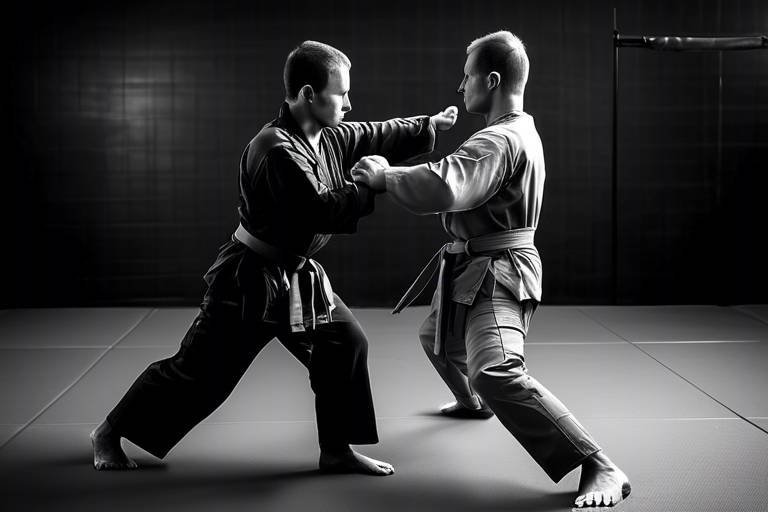Understanding the Legal Aspects of Self-Defense Techniques
When it comes to self-defense, the law can often feel like a maze filled with twists and turns. The concept of self-defense is not just about instinctively reacting to a threat; it’s a complex legal framework that varies by jurisdiction and circumstance. Understanding this framework is crucial for anyone looking to protect themselves while staying within the bounds of the law. So, what exactly does self-defense mean in a legal context? And how can individuals navigate this intricate landscape?
At its core, self-defense is defined as the right to use reasonable force to protect oneself from imminent harm. However, the intricacies of this definition can lead to confusion. For instance, what constitutes "reasonable" force? Is it the same across all states? These questions underline the importance of grasping the legal nuances surrounding self-defense techniques. Not only do individuals need to know when they can act in self-defense, but they also need to understand the potential consequences of their actions if they misinterpret the law.
As we dive deeper into this topic, we will explore various legal justifications for self-defense, including principles such as necessity and proportionality. These concepts are essential in determining whether an individual acted lawfully when faced with a threat. Imagine you’re walking home late at night, and someone approaches you aggressively. Your instinct might be to fight back, but understanding the legal backdrop can help you make a more informed decision about how to respond.
Moreover, we will discuss the Duty to Retreat, which is a critical factor in many self-defense cases. This principle requires individuals to avoid confrontation if it’s safe to do so. However, not all jurisdictions enforce this duty equally, leading to varied interpretations of self-defense claims. For example, some states mandate that you must retreat before using force, while others allow you to stand your ground. This brings us to the concept of Stand Your Ground Laws, which permit individuals to use force without retreating in certain situations. Understanding these laws can be the difference between a justified defense and a legal nightmare.
Additionally, the Castle Doctrine offers legal protection for individuals defending their homes. This doctrine acknowledges that one has the right to protect their residence from intruders. But how far does this protection extend? Exploring the scope of the Castle Doctrine can provide clarity on what actions are legally permissible when defending one’s home.
As we navigate through these laws, we’ll also touch on the concept of reasonable force. What does it mean to use reasonable force in a self-defense scenario? This section will outline the criteria that courts often consider, such as the severity of the threat and the level of force used in response. Understanding these criteria is vital, as they significantly influence legal outcomes in self-defense claims.
Lastly, we will examine the legal consequences of misapplying self-defense. It’s crucial to understand that misinterpreting the law can lead to severe repercussions, including criminal charges and civil liabilities. The stakes are high, and being well-informed can make a significant difference in the outcome of a self-defense case.
- What is the legal definition of self-defense? Self-defense is the right to protect oneself from harm using reasonable force.
- Do I have to retreat before using force? It depends on the laws of your state; some require a duty to retreat, while others have Stand Your Ground laws.
- What is the Castle Doctrine? This doctrine allows individuals to use force to protect their homes from intruders without the obligation to retreat.
- What constitutes reasonable force? Reasonable force is determined by the circumstances of the threat and the response; it varies case by case.
- What are the consequences of misapplying self-defense? Misapplying self-defense can lead to criminal charges and civil liabilities.

The Definition of Self-Defense
Self-defense is not just a term thrown around in movies or barroom brawls; it’s a legal concept that carries significant weight in our judicial system. At its core, self-defense refers to the right of an individual to protect themselves from imminent harm. This right is recognized in many legal systems around the world, but the specifics can vary widely. Understanding what self-defense really means is crucial for anyone considering the use of force to protect themselves.
In legal terms, self-defense typically encompasses a few key elements:
- Imminent Threat: There must be an immediate threat to your safety. This means that the danger must be real and present, not hypothetical or perceived.
- Reasonable Belief: The individual claiming self-defense must have a reasonable belief that they are in danger. This belief is often assessed from the perspective of a reasonable person in similar circumstances.
- Proportional Response: The response to the threat must be proportional. This means that the force used in self-defense should not exceed what is necessary to prevent the harm.
For example, if someone is confronted by an aggressive individual who is threatening them with physical harm, they may have the right to defend themselves. However, if the person responds with lethal force when it is not warranted, that could lead to legal repercussions. The key takeaway here is that self-defense is about balance—protecting oneself while adhering to the law.
Furthermore, self-defense is often categorized into two main types: active self-defense and passive self-defense. Active self-defense involves taking direct action against an aggressor, such as using physical force or weapons. On the other hand, passive self-defense might include strategies like avoiding confrontation or escaping a dangerous situation. Understanding these distinctions can be essential in determining the best course of action in a threatening scenario.
In summary, self-defense is a complex legal concept that hinges on the principles of necessity, reasonableness, and proportionality. It is vital for individuals to familiarize themselves with these principles, as well as the specific laws in their jurisdiction, to ensure that they can effectively protect themselves without crossing the legal boundaries.
- What is the primary purpose of self-defense laws?
Self-defense laws aim to allow individuals to protect themselves from harm while ensuring that the use of force is justified and not excessive. - Can you use self-defense if you provoke a fight?
Generally, if you instigate a confrontation, you may not be able to claim self-defense unless you withdraw from the situation and the other party continues to threaten you. - Does self-defense apply outside of the home?
Yes, self-defense laws apply in public spaces as well, but the specifics can vary by jurisdiction.

Legal Justifications for Self-Defense
When it comes to self-defense, the legal justifications are like the foundation of a house; they support everything that follows. Understanding these justifications is essential for anyone who might find themselves in a situation where they need to protect themselves. The two primary legal principles that underpin self-defense are necessity and proportionality. Let's break these down a bit.
Necessity refers to the idea that self-defense is only justified when there is an immediate threat to your safety. Imagine walking down a dark alley and suddenly being confronted by an aggressor. If you feel that your life is in danger, the necessity of defending yourself becomes clear. However, if you were to use self-defense in a situation where the threat was minimal or avoidable, the justification might not hold up in court.
On the other hand, proportionality is about the response to the threat. The force you use in self-defense must be proportional to the threat you face. For example, if someone pushes you in a bar fight, responding with lethal force would likely be seen as excessive and unjustifiable. It’s like using a sledgehammer to crack a nut; it’s overkill and not legally justifiable. The law expects you to use only the amount of force necessary to neutralize the threat.
In many jurisdictions, these principles work hand-in-hand. If you can establish that you acted out of necessity and that your response was proportional, you're on much firmer legal ground. However, the application of these principles can vary widely depending on the state or country you are in, which is why understanding your local laws is crucial.
As you navigate these concepts, it’s important to remember that the legal system is complex and often requires a thorough understanding of the nuances involved. This is where case law comes into play, as it provides real-world examples of how courts have interpreted necessity and proportionality in self-defense cases.
In summary, the legal justifications for self-defense—necessity and proportionality—are fundamental to understanding how to protect yourself while remaining within the bounds of the law. Each situation is unique, and the specifics matter greatly. If you ever find yourself in a confrontational scenario, keeping these principles in mind could make all the difference in how your actions are perceived legally.

Duty to Retreat
The is a legal principle that requires individuals to avoid using force, if possible, by retreating from a threatening situation. This concept is rooted in the idea that violence should always be a last resort. Imagine you're at a party, and an argument breaks out. Instead of escalating the situation, the law encourages you to step back, diffuse the tension, and leave the scene if you can. This principle varies significantly across jurisdictions, making it essential to understand how it applies in your area.
In many places, the duty to retreat is a critical factor in determining whether a claim of self-defense is justifiable. For instance, if someone is attacked, they may be expected to retreat to safety before resorting to defensive force. However, this expectation can be quite nuanced. Some states have a strict duty to retreat, meaning that if you fail to retreat when you could have, your self-defense claim may be weakened or rejected altogether. On the other hand, some jurisdictions have adopted Stand Your Ground laws, which eliminate the duty to retreat, allowing individuals to defend themselves without attempting to escape first.
To illustrate the differences, consider the following table that outlines how the duty to retreat is treated in various states:
| State | Duty to Retreat | Stand Your Ground Law |
|---|---|---|
| California | Yes | No |
| Florida | No | Yes |
| New York | Yes | No |
| Texas | No | Yes |
Understanding the duty to retreat is vital for anyone considering self-defense techniques. It’s not just about knowing how to defend yourself; it's about knowing when and how to do so legally. In situations where retreat is possible, failing to do so can lead to serious legal repercussions. Courts often scrutinize whether a person had a safe escape route before engaging in self-defense. Therefore, being aware of your surroundings and the legal expectations in your state can be the difference between a justified self-defense claim and facing criminal charges.
Ultimately, the duty to retreat serves as a reminder that self-defense should not be taken lightly. It emphasizes the importance of de-escalation and personal safety over confrontation. So, the next time you find yourself in a potentially dangerous situation, remember: sometimes, the bravest thing you can do is to walk away.
- What is the duty to retreat? The duty to retreat is a legal obligation to avoid using force by retreating from a threatening situation, where possible.
- Do all states have a duty to retreat? No, not all states have a duty to retreat. Some states have enacted Stand Your Ground laws that eliminate this requirement.
- What happens if I fail to retreat? If you fail to retreat when you could have, it may weaken your self-defense claim and could lead to legal consequences.
- How can I know my state's laws on self-defense? It’s essential to research your state’s specific laws or consult with a legal expert to understand your rights and obligations regarding self-defense.

Stand Your Ground Laws
Stand Your Ground laws represent a significant shift in the legal landscape regarding self-defense. Unlike traditional self-defense laws that often require individuals to retreat from a threatening situation if it is safe to do so, Stand Your Ground laws allow individuals to use force, including deadly force, without the obligation to retreat. This means that if someone feels threatened, they can take action to protect themselves without first attempting to escape. This legal principle is rooted in the belief that individuals have the right to protect themselves in any place they have a legal right to be, without the fear of legal repercussions.
These laws have sparked considerable debate and controversy. Proponents argue that Stand Your Ground laws empower individuals to defend themselves against aggressors, potentially deterring crime. They believe that these laws affirm the right to self-defense, especially in dangerous situations where retreat may not be a viable option. Critics, on the other hand, argue that these laws can lead to unnecessary violence and may encourage confrontations that could have been avoided. They express concern that such laws disproportionately affect marginalized communities and can result in tragic outcomes.
To better understand the implications of Stand Your Ground laws, it's essential to consider their origins and how they vary by state. Most of these laws emerged in the early 2000s, with Florida being one of the first states to adopt such legislation. Since then, numerous states have followed suit, each with its own nuances and stipulations. Below is a table summarizing some key aspects of Stand Your Ground laws across different states:
| State | Stand Your Ground Law | Duty to Retreat |
|---|---|---|
| Florida | Yes | No duty to retreat |
| Texas | Yes | No duty to retreat |
| California | No | Duty to retreat required |
| New York | No | Duty to retreat required |
As you can see from the table, states like Florida and Texas allow individuals to stand their ground without any obligation to retreat, while states like California and New York require individuals to attempt to retreat before using force. This discrepancy can lead to confusion and varying outcomes in self-defense cases, depending on where an incident occurs.
Ultimately, understanding Stand Your Ground laws is crucial for anyone interested in self-defense. Whether you are a law-abiding citizen seeking to protect yourself or simply interested in the legal implications of these laws, knowing your rights and responsibilities can make all the difference in a critical situation. As these laws continue to evolve, it is essential to stay informed about the legal landscape in your specific jurisdiction.
- What are Stand Your Ground laws? These laws allow individuals to use force without the obligation to retreat in threatening situations.
- Do all states have Stand Your Ground laws? No, laws vary by state; some states require a duty to retreat.
- What should I do if I am involved in a self-defense incident? Contact legal counsel immediately to understand your rights and obligations.

Castle Doctrine
The is a legal principle that grants individuals the right to use reasonable force, including deadly force, to protect themselves against intruders in their homes. Think of it as a legal shield that allows you to defend your sanctuary without the obligation to retreat. This doctrine is rooted in the belief that a person's home is their castle, a place where they should feel safe and secure. When someone unlawfully enters that space, the law recognizes that the homeowner has the right to defend themselves and their loved ones.
However, the specifics of the Castle Doctrine can vary significantly from one jurisdiction to another. In some states, the law is quite broad, allowing homeowners to use force without any duty to retreat, while in others, the circumstances under which force can be applied may be more limited. For instance, in jurisdictions with a strict interpretation of the Castle Doctrine, the homeowner must demonstrate that they genuinely believed they were in imminent danger of death or serious bodily harm before resorting to force.
It's also important to note that the Castle Doctrine typically applies only to one's home, but some states extend this protection to vehicles and workplaces, recognizing these as extensions of a person's home. This extension can create a complex legal landscape, as individuals must understand not only their rights but also the responsibilities that come with them.
To illustrate the variations in the Castle Doctrine, here's a simplified comparison of how different states approach the doctrine:
| State | Castle Doctrine Status | Duty to Retreat |
|---|---|---|
| Florida | Strong Castle Doctrine | No Duty to Retreat |
| California | Limited Castle Doctrine | Duty to Retreat in Some Cases |
| Texas | Broad Castle Doctrine | No Duty to Retreat |
| New York | Limited Castle Doctrine | Duty to Retreat Required |
In conclusion, while the Castle Doctrine provides essential protections for homeowners, it is crucial to understand the specific laws in your state. Misunderstanding these laws can lead to serious legal consequences. Always consider consulting with a legal expert if you find yourself navigating these complex waters. It’s better to be informed than to be caught off guard when it comes to protecting your home and your rights.
- What is the Castle Doctrine? The Castle Doctrine allows individuals to use force to defend themselves in their homes without the duty to retreat.
- Does the Castle Doctrine apply outside the home? Some states extend the doctrine to vehicles and workplaces, but this varies by jurisdiction.
- Can I use deadly force under the Castle Doctrine? Yes, but only if you genuinely believe you are in imminent danger of death or serious bodily harm.
- What happens if I misuse the Castle Doctrine? Misapplying the doctrine can lead to criminal charges or civil liabilities.

Understanding Reasonable Force
When it comes to self-defense, one of the most crucial concepts to grasp is reasonable force. This term refers to the amount and type of force that a person is justified in using to protect themselves or others from imminent harm. But how do we define what is "reasonable"? It's a bit like trying to find the perfect balance on a seesaw; too much force can lead to severe legal consequences, while too little may leave you vulnerable to harm.
In legal terms, reasonable force is often assessed based on several factors, including the nature of the threat, the circumstances surrounding the encounter, and the actions of both the defender and the aggressor. For instance, if someone is approaching you with a weapon, using physical force to defend yourself might be considered reasonable. However, if the threat is merely verbal, responding with deadly force would likely be seen as excessive and unjustifiable.
To better understand reasonable force, let's break down some key criteria that courts often consider:
- Immediacy of the Threat: The threat must be immediate and unavoidable. If you have time to retreat or seek help, using force may not be justified.
- Proportionality: The force used in self-defense must be proportionate to the threat faced. For example, using a baseball bat against someone who is pushing you could be deemed excessive.
- Intent: The intent behind the use of force matters. If the defender intended to cause harm, that could change the legal interpretation of their actions.
- Ability to Escape: If there was a viable opportunity to escape the situation without using force, that could influence the assessment of reasonable force.
It's essential to realize that what is considered reasonable can vary widely based on the specific circumstances and the laws of your jurisdiction. For example, in some states, the law may allow for a broader interpretation of reasonable force in self-defense situations, while others may impose stricter limitations. This is why understanding local laws is vital.
Furthermore, the concept of reasonable force is not just about physical actions; it also encompasses the mental state of the person defending themselves. Courts often evaluate whether a reasonable person in the same situation would have felt threatened and acted similarly. This subjective element adds another layer of complexity to self-defense claims.
In conclusion, grasping the nuances of reasonable force is essential for anyone considering self-defense techniques. It's like navigating a minefield—one misstep could lead to significant legal repercussions. Therefore, always be aware of your surroundings, know your local laws, and, when in doubt, seek non-violent solutions to conflicts whenever possible.
- What is the difference between reasonable force and excessive force? Reasonable force is the minimum amount of force necessary to prevent harm, while excessive force goes beyond what is necessary, potentially leading to legal consequences.
- Can I use reasonable force to protect others? Yes, in many jurisdictions, you can use reasonable force to protect another person from harm, but the same criteria for assessing reasonable force apply.
- What should I do if I am involved in a self-defense situation? If you find yourself in a self-defense situation, it’s crucial to report the incident to law enforcement and seek legal advice to navigate the aftermath correctly.

State-Specific Self-Defense Laws
When it comes to self-defense, one size definitely does not fit all. Each state in the U.S. has its own unique set of laws governing the use of self-defense techniques. This variation can be as stark as night and day, making it essential for individuals to be aware of the legal framework in their specific state. For instance, some states embrace Stand Your Ground laws, allowing individuals to use force without the obligation to retreat, while others impose a duty to retreat before using force, even in the face of imminent danger.
Understanding these differences is crucial, especially for those who may find themselves in situations where self-defense becomes necessary. For example, in states like Florida and Texas, the legal system supports the notion that individuals have the right to protect themselves without retreating, effectively giving them the green light to stand their ground. On the flip side, states like New York and California require individuals to retreat, if it's safe to do so, before resorting to force. This is where the nuances of state law come into play, and ignorance of these laws can lead to severe consequences.
Here’s a quick look at some of the key aspects of self-defense laws across different states:
| State | Duty to Retreat | Stand Your Ground | Castle Doctrine |
|---|---|---|---|
| Florida | No | Yes | Yes |
| California | Yes | No | Yes |
| Texas | No | Yes | Yes |
| New York | Yes | No | Yes |
This table illustrates just a few examples, but it’s important to note that even within these categories, there can be significant legal differences. For instance, what constitutes "reasonable force" can vary widely depending on the jurisdiction. In some states, the law may allow for lethal force if someone feels threatened, while others might only permit non-lethal options unless the threat level is extremely high. This discrepancy underscores the importance of knowing your local laws.
Moreover, individuals must also consider the context of their actions. For example, if a person is attacked in a bar, their right to self-defense may be viewed differently than if they were attacked in their own home. The circumstances surrounding each incident can dramatically affect legal outcomes. Therefore, it’s crucial for anyone interested in self-defense to not only understand the laws in their state but also to stay informed about any changes to those laws.
In conclusion, navigating the labyrinth of state-specific self-defense laws can feel overwhelming, but it’s a necessary endeavor for anyone looking to protect themselves legally. Always consult with a legal professional or local law enforcement to clarify any doubts you may have regarding your rights and responsibilities in self-defense situations. After all, being informed is the best defense!
- What should I do if I need to use self-defense? Always ensure that your actions are in line with your state's laws. If possible, retreat from the situation and seek help.
- Can I use self-defense in my home? Yes, many states have laws that protect individuals using self-defense in their homes, often referred to as the Castle Doctrine.
- What happens if I misuse self-defense? Misapplying self-defense can lead to criminal charges and civil liabilities, so it's crucial to understand the laws fully.

Case Law Precedents
When it comes to understanding self-defense laws, examining is crucial. These legal decisions not only shape the interpretation of self-defense but also provide a roadmap for how similar cases may be handled in the future. Think of case law as the living history of legal principles—it evolves with each ruling, reflecting societal changes and judicial philosophies. Let's dive into a few landmark cases that have made a significant impact on self-defense laws.
One of the most notable cases is Castle Rock v. Gonzales (2005), where the U.S. Supreme Court ruled that a woman could not hold the police liable for failing to enforce a restraining order against her estranged husband, who later killed their children. This case highlighted the complexities surrounding the duty to protect and the limitations of legal recourse in self-defense scenarios. It raised questions about the responsibilities of law enforcement and the rights of individuals to protect themselves and their families.
Another significant case is People v. Goetz (1986), which involved a man who shot four teenagers on a subway train in New York City, claiming he felt threatened. The jury ultimately acquitted him, but the case sparked widespread debate about what constitutes reasonable fear and the appropriate use of force in self-defense situations. Goetz's actions prompted discussions about the balance between personal safety and public safety, leading to a reevaluation of how self-defense is perceived in urban environments.
In addition to these cases, the Florida v. Zimmerman (2012) case also stands out. George Zimmerman shot and killed Trayvon Martin, claiming self-defense under Florida's Stand Your Ground law. The case ignited national outrage and discussions about race, gun laws, and the implications of self-defense claims. Ultimately, Zimmerman was acquitted, but the case prompted a reexamination of Stand Your Ground laws and their potential for misuse.
These cases illustrate that self-defense is not a straightforward concept; it is subject to interpretation and influenced by various factors, including the context of the incident, the perceived threat, and the jurisdiction's laws. Courts often rely on precedent to guide their decisions, making it essential for individuals to understand the legal landscape surrounding self-defense in their specific state.
As we explore the implications of these case law precedents, it becomes evident that the legal definitions and standards for self-defense continue to evolve. The outcomes of these cases serve as a reminder that while individuals have the right to protect themselves, the context and circumstances surrounding their actions will ultimately determine the legality of their self-defense claims.
- What is the primary requirement for a self-defense claim? A self-defense claim typically requires that the individual felt an imminent threat of harm.
- Can I use deadly force in self-defense? Deadly force is only justified if there is a reasonable belief that it is necessary to prevent imminent death or serious bodily harm.
- What is the difference between Stand Your Ground and Duty to Retreat? Stand Your Ground laws allow individuals to use force without retreating, while the Duty to Retreat requires individuals to avoid confrontation if possible.
- How can case law affect my self-defense case? Case law provides precedents that can influence the outcome of your case based on similar situations and judicial interpretations.

Legal Consequences of Misapplication
When it comes to self-defense, the line between justified action and unlawful behavior can be razor-thin. Misapplying self-defense can lead to severe legal repercussions that not only affect the individual involved but can also have broader implications for the community. Imagine a scenario where someone feels threatened and responds with force, only to find themselves facing criminal charges. This is not just a possibility; it’s a reality that many individuals have faced. The law does not take kindly to those who misuse the concept of self-defense, and understanding these consequences is crucial.
One of the most immediate consequences of misapplying self-defense is the potential for criminal charges. Depending on the jurisdiction and the specific circumstances of the incident, individuals may find themselves charged with offenses such as:
- Assault: Even if the intent was to defend oneself, if the force used is deemed excessive or unnecessary, charges of assault can arise.
- Battery: This involves the unlawful use of force against another person, which can lead to significant legal penalties.
- Homicide: In the most severe cases, if a self-defense claim results in the death of another person, the individual may face homicide charges, ranging from manslaughter to murder.
In addition to criminal charges, individuals may also face civil liabilities. Victims of what is perceived as unjustified self-defense may file lawsuits seeking damages for injuries sustained during the altercation. The financial repercussions can be staggering, as legal fees, medical bills, and potential settlements can quickly add up. This aspect highlights the importance of understanding not just the legal definitions of self-defense, but also the practical implications of its application.
Furthermore, the burden of proof in self-defense cases often lies with the defendant. This means that individuals must provide evidence that their actions were reasonable and necessary under the circumstances. If they fail to meet this burden, they may not only face criminal penalties but also damage their reputation and personal relationships. The social stigma associated with being accused of misusing self-defense can linger long after the legal proceedings have concluded.
To summarize, the legal consequences of misapplying self-defense techniques can be extensive and detrimental. Individuals may face a range of criminal charges, civil liabilities, and long-lasting social repercussions. It’s essential to approach self-defense with a clear understanding of the law and to seek legal advice when necessary. After all, protecting oneself should never come at the cost of violating the rights of others or breaking the law.
1. What should I do if I am involved in a self-defense incident?
Immediately contact law enforcement and seek legal counsel to navigate the complexities of self-defense laws in your jurisdiction.
2. How can I ensure my self-defense actions are legally justified?
Understanding the principles of necessity and proportionality, as well as familiarizing yourself with local laws, can help ensure your actions are justified.
3. What are the potential penalties for misapplying self-defense?
Penalties can range from fines and community service to imprisonment, depending on the severity of the incident and the laws of your state.
4. Can I be sued for using self-defense?
Yes, individuals can face civil lawsuits if the use of self-defense is deemed excessive or unwarranted.
Frequently Asked Questions
- What is the legal definition of self-defense?
Self-defense is a legal term that allows individuals to protect themselves from imminent harm. It's essential to understand that this right is not absolute and depends on the specific circumstances surrounding each incident.
- What are the key legal justifications for using self-defense?
The primary justifications for self-defense include necessity and proportionality. Necessity implies that the use of force is essential to prevent harm, while proportionality means that the level of force used must be appropriate to the threat faced.
- What is the duty to retreat?
The duty to retreat requires individuals to avoid confrontation if it is safe to do so. This legal obligation varies by jurisdiction, with some places enforcing strict retreat laws while others, like those with Stand Your Ground laws, do not.
- What are Stand Your Ground laws?
Stand Your Ground laws permit individuals to use force without the obligation to retreat in certain situations. These laws have sparked debate over their implications for public safety and the potential for misuse.
- How does the Castle Doctrine apply to self-defense?
The Castle Doctrine provides legal protection for individuals defending their homes. It often allows for the use of reasonable force against intruders without the duty to retreat, reinforcing the right to feel secure in one’s residence.
- What constitutes reasonable force in self-defense cases?
Reasonable force is determined by assessing the threat level and the response to it. Courts consider factors such as the size and strength of the parties involved, the context of the confrontation, and whether the response was appropriate to the situation.
- Do self-defense laws vary by state?
Yes, self-defense laws can differ significantly from state to state. It's crucial to be aware of the specific laws in your jurisdiction, as they may influence the legal outcomes of self-defense claims.
- How does case law impact self-defense interpretations?
Case law plays a significant role in shaping the standards and interpretations of self-defense. Landmark cases often set precedents that influence how future self-defense claims are evaluated in court.
- What are the legal consequences of misapplying self-defense?
Misapplying self-defense can lead to severe legal repercussions, including criminal charges for assault or homicide and civil liabilities. Understanding the risks involved is essential for anyone considering the use of self-defense techniques.



















